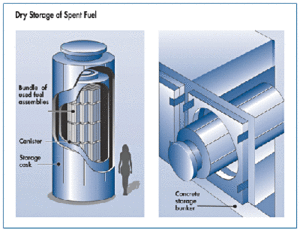Nuclear mattersZion's nuclear dry-cask storage solution
In Illinois, 28,588 fuel assemblies, each containing a bundle of 200 rods and weighing about 600 pounds, are cooling in pools on the ground or above reactors — as in Japan; experts say they are “very inviting targets for terrorists”; moreover, “No one has come up with a solution to safely store this waste for 10,000 years into the future”

Schematic of the dry-cask solution // Source: nrc.gov
Fourteen years ago, Zion nuclear power plant’s last red-hot fuel rod was lifted from its reactor core and submerged into a pool of water, joining the rest of the plant’s 2.2 million pounds of spent fuel. Despite plans to entomb the nuclear waste within Nevada’s Yucca Mountain, the U.S. Energy Department left Zion operators with the responsibility of storing the dangerous materials on site. Chicago-based Exelon Corp. shuttered Zion in 1998 and another company is dismantling the complex piece by piece. The plan calls for Zion’s waste to be encased in concrete-and-steel bunkers not far from Lake Michigan, possibly in perpetuity.
In the wake of Japan’s disaster, the safety calculation involved in storing such waste has changed, experts say. More than 80 percent of the spent nuclear fuel in Illinois remains in pools.
In Zion, a town of 25,000 about fifty miles north of Chicago, and at other towns where nuclear waste is stored, Japan’s crisis has some questioning if the most unlikely events could happen and whether they would be protected.
In Illinois, 28,588 fuel assemblies, each containing a bundle of 200 rods and weighing about 600 pounds, are cooling in pools on the ground or above reactors as in Japan.
Positioned, up high, they are “very inviting targets for terrorists,” said David Lochbaum, director of the Nuclear Safety Project of the Union of Concerned Scientists, and critics note that the buildings that house the pools are flimsy.
“No one has come up with a solution to safely store this waste for 10,000 years into the future,” said Lochbaum.
The Energy Department says it is committed to ensuring it meets its long-term disposal obligations, but a plan hasn’t been disclosed.
For safety reasons, law requires spent rods to cool in pools for five years before they can be moved into dry casks — stainless-steel canisters, encased in 3-inch-thick carbon-steel liners and covered in two feet of reinforced concrete.
Installing dry-cask storage infrastructure at a plant with two reactors would cost between $20 million and $30 million, and annual costs for buying casks, loading them and running a dry-cask storage facility are $7 million to $10 million, according to Exelon. Unlike in Japan, Zion’s fuel rods have been cooling for as long as forty years.
“You can’t have a meltdown,” said Patrick Daly, general manager of EnergySolutions, which is dismantling Zion.
By 2020, EnergySolutions expects to turn the 240-acre site into an uncontaminated field of grass. Unless the federal government comes up with an alternative, ten to fifteen acres of the land will be home to sixty-one concrete and steel dry casks, each weighing 125 tons, used to store the spent fuel.
At a panel discussion Friday focused on Japan’s crisis and hosted by the Chicago Council on Global Affairs, Robert Gallucci, president of the John D. and Catherine T. MacArthur Foundation, said the concrete monoliths were “a good interim solution” to the storage problem. He said he was a “very enthusiastic supporter of long-term dry storage.” Gallucci previously served with the U.S. State Department as a special envoy focused on the threat posed by the proliferation of weapons of mass destruction.
Even Lochbaum calls dry-cask storage “the cheapest insurance we can possibly pay.”
So far, none of Zion’s waste has been moved into dry casks. This summer a pad is to be built about 2,000 feet from Lake Michigan that would protect the casks from earthquakes.
Daly said spent fuel will be moved into dry casks by 2014. Meanwhile, cooling occurs through natural convection.
